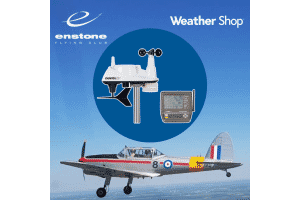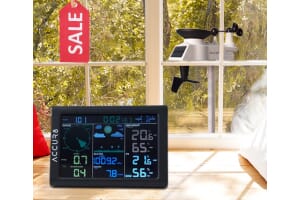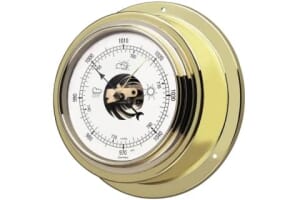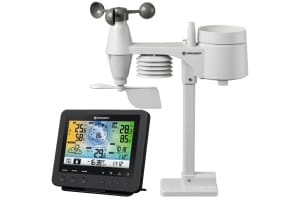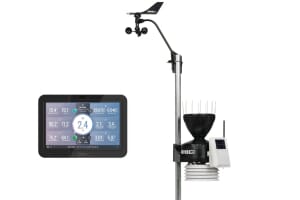
-
Posted: May 12, 2019Categories: Community SupportRead more »
Since 2017, Weather Shop and our customers have supported the work of Stonepillow, a Sussex-based charity that offers shelter, information and support to empower homeless and vulnerable individuals to make positive changes in their lives.
We include an optional donation of £2.50 to Stonepillow in the purchase price of one of our popular weather forecaster stations, the TechnoLine 'Weather Man'. Weather Shop matches every customer donation with a further £2.50 donation. So far, the donations have amounted to £825!
-
Posted: February 25, 2018Read more »
We write lots of posts to help you get the best out of your weather station – including advice on buying, location, maintenance and wider meteorological topics. Here are some of our most popular; to check out the rest – head to our KnowledgeBase
-
Posted: January 03, 2018Categories: Tips and TricksRead more »
For most uses, its best to take a pragmatic view of where to install your weather station. Bear in mind that you want readings for your location 'warts and all', and not a open space somewhere else. Very often the location will be affected by the local urban, commercial, geographic and vegetation topography.
Temperature and Humidity Sensor
Your temperature and humidity sensors are best located in a shaded environment out of direct sunlight and weather. The north facing side of a wall or fence is good, but bear in mind radiated heat from an occupied building. A purpose-made screen will help, or even a home-made one such as a white ice cream tub with ventilation holes. Force ventilating the screen will further improve accuracy and response.
If you have to mount it in a sunny location, then shade it behind something e.g. a shiny biscuit tin lid painted black on the reverse.
-
Posted: December 20, 2017Read more »
Firstly, to cover off measuring the actual depth of snow. By far the simplest method is to use a ruler! Remember that its just an indication of how much snow is on the ground, not how much snow has actually fallen, much may have melted or sublimated (evaporated, which can occur in very dry, sunny or windy conditions). Find a flat area (such as your lawn) away from drifts or any obstacle likely to have caused an obstruction to falling snow; even trees and bushes 2-3 metres away can create areas of uneven depth, especially when it has been windy. We measure to the nearest cm and report the snow depth at least once a day, at 09Z, if possible.
The amount of snow can also be measured by what is known as its 'water equivalent'. The problem is that unless you've got a heated rain gauge (and the UK Met Office does use these), any snow will not drip through into the tipping bucket mechanism either at all or at the time corresponding to that in which in fell in, unless it is very wet. If too
-
Posted: November 23, 2017Read more »
Davis are top-quality USA made weather instruments, built for long-term accuracy and reliability. However, they still benefit from a little TLC from time-to-time to help them continue to perform to their potential. Read on for tips on how to maintain and clean a Davis Vantage Vue or Davis Vantage Pro 2 Weather Station.
Anemometer
Your anemometer should provide years of service. In some areas however, spiders and insects can affect operation. If wind speed seems low, use an allen key wrench to loosen the setscrew on the side of the wind cups. Remove the wind cups, and clean the exposed portion of the shaft with a damp cloth
-
Posted: November 22, 2017Read more »
We learn to live with the weather from almost as soon as we are born. It affects our moods, our health, our work and indeed the relationships we have with others. It is worth understanding a little more about the topic simply because there is little else that has so much of an impact on our everyday lives. We may try and shut it out, create our own micro climates: central heating, air conditioning and double glazing but one way or the other it is likely to affect us. The price we pay for our consumer services is very often in some way dictated, to a greater or lesser extent, by what the weather has been doing in the past month. With the greater emphasis we now place in the 21st century on understanding climatic change and the influence that this also has on our society, there has never been a better time to understand something of the basics of the science of meteorology; the weather.
The definition of the science of the weather
-
Posted: November 21, 2017Categories: General InterestRead more »
As could be seen in part two of this potted history, the Admiralty was reasonably well prepared for the onset of hostilities. Four years previously, in 1935, documents were produced authorising aircraft carriers, battleships and larger cruisers to be equipped according to their status and advising on the location of the Met Office and balloon shelter; also the siting of certain crucial, and delicate, meteorological instruments in order that they were able to function in the desired manner.
As could be seen in part two of this potted history, the Admiralty was reasonably well prepared for the onset of hostilities. Four years previously, in 1935, documents were produced authorising aircraft carriers, battleships and larger cruisers to be equipped according to their status and advising on the location of the Met Office and balloon shelter; also the siting of certain crucial, and delicate, meteorological instruments in order that they were able to function
-
Posted: November 20, 2017Read more »
We may find a number of elements causing problems outside in the garden during the winter months. These include frost, and penetrating cold, high winds, heavy snow and heavy rain causing waterlogged ground.
Usually dry winters present the least problem, not least because even a dry winter sees far less water loss through evaporation and transporation than even a mid autumn month. However, with dry winters can come chill northerly or easterly winds of course. Whilst very cold weather is often blamed for plant loss, in fact it's usually the combination of the wind with very cold temperatures. Such early cold in November and early December is particularly problematic, as deciduous plants are very vulnerable then- because they are not yet fully dormant. Longer periods of severe weather (of more than a week) will also likely be damaging later in the winter. It is possible to minimise the damage likely by both wind and penetrating cold, though.
Strong
-
Posted: November 20, 2017Categories: General InterestRead more »
The meteorologist’s skills as used during WW1 must have been of use, particularly to the Royal Navy aviation world as once hostilities ceased, for those officers who had a particular interest in the weather; cessation did not appear to be an option. Although the majority of their work was done, these intrepid future RN Forecasters continued using their knowledge alongside their other duties on board ship.
At this time it did not really occur to anyone that these skills could be transferred to the shore bases where a few planes were still based. True most of the aerodromes had been transferred to the newly formed Royal Air Force, but now that the Naval Air Service (NAS) had disbanded, Royal Naval Air Stations (RNAS) were beginning to come into being, after all aircraft carriers were beginning to come into their own and when the ships were not at sea or were being refitted it was necessary to store the planes somewhere. Most of these stores were part of
-
Posted: October 25, 2017Categories: EducationRead more »
We often receive calls from schools who remember having a Stephenson Screen in their school grounds as a child which is where they went to get the temperature readings. We still agree that this is a valuable way of enhancing your students experience of weather, however there is only so much you can measure in this way - temperature and humidity!
Therefore the benefit that electronic, or Automated Weather Stations (AWS), provide students is enormous. As discussed earlier AWS can be used in meteorology (as part of Geography), science and technology, maths, communications and media, and ICT.
We are often informed that weather data for all areas of the UK and world can be gained so easily from the world-wide web, so why would you use your budget to purchase an AWS for your school or educational establishment?
One teacher who had purchased from us summed it up well: He had been using an online weather data source for several years, then one day he went to it it was no

